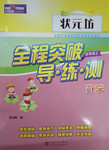题目内容
can, may, should, ought to, had better
1. You________ help Jack as his best friend, since he is now in trouble.
2.—________ I leave now, Miss White?
—No, you________ .You________finish the exercises first.
3. It’s 8 o’clock. Mr. Smith________be here at any moment.
4. You look tired. You________ have a good rest.
5.—Are you coming to the party?
—I________come, but I’m not sure.
6. I’d like to ask a question if I________ .
答案:
解析:
提示:
解析:
1. should/ought to 2. May/ Can,can't,should/ought to 3. should/ought to 4. had better 5. may 6. may 这里考查情态动词的用法,注意should=ought to。
|
提示:
|

练习册系列答案
 状元坊全程突破导练测系列答案
状元坊全程突破导练测系列答案 直通贵州名校周测月考直通名校系列答案
直通贵州名校周测月考直通名校系列答案
相关题目
You ______go and ask Lily . She ______know the answer.
|
A.must, can |
B.must, may |
C.need, can |
D.can, may |